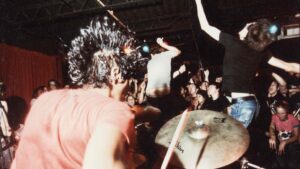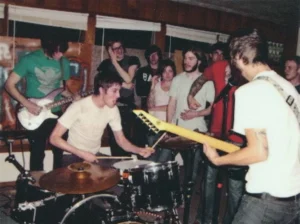Sasscore and the Emergence of Counter Counterculture
By Peyton K.

It may seem impossible to envision a genre of music that somehow rebels against both mainstream culture and counterculture. However, the genre of sasscore manages to exist in a unique position where it is able to defy both at once. Sasscore (also known as sassy screamo, sassgrind, or dancey screamo) is a style of music originating from hardcore punk and screamo, with the genre starting to take shape in the late ‘90s/early ‘00s and solidifying in the mid-2000s/early 2010s. Influences for sasscore can be traced back to post-punk, electronic, dance-punk, emoviolence, new wave, and even disco at some times (1).
Musical characteristics of sasscore include blast beats, chaotic guitars, danceable rhythms, and the use of synthesizers (7). The term “sass” in the subgenre’s name refers to its bold, often raunchy vocal expression and lyrics. At sasscore shows, it wouldn’t be uncommon to witness flamboyant mannerisms, a lisping vocal style, and erotic lyrics. Sasscore can be related to many relevant social issues such as the existence of “counterculture”, toxic and forced masculinity, and queer musicians in alternative spaces.
In order to understand why the subgenre of sasscore was created, it’s important to understand the broader history of hardcore punk. Hardcore punk (often shortened to “hardcore”) originated in the late 1970s and is defined by its aggressive sound, rougher vocals, and fast riffing. Popular hardcore bands in the 20th century include Black Flag, Minor Threat, and Bad Brains (also mentioned in Week 9). Apart from the musical characteristics, one of the most important aspects of hardcore was its original set of ethics—ethics that separated hardcore from mainstream music and cemented it as part of counterculture in the first place. These ethics include a “DIY attitude”, dedication to social activism, anti-consumerism, rejection of hierarchy, a commitment to fighting against oppression in all forms, and most importantly, nonconformity (9).
However, the popularization of hardcore in the late 20th century also came with the bastardization of these ethics. The angry and confident noise of the genre quickly attracted many with only a surface-level understanding of its original values. Soon, straight-edge crews and youth crews (large clubs of people who attended and patrolled shows) began to gain popularity in the hardcore scene, further driving herd mentalities. Suddenly, the ideas of machismo and a “tough guy mentality” were popularized in the hardcore scene, taking away from the genre’s original message of individuality and defying the status quo (8). Although there were some exceptions to this idea of hardcore and overt masculinity going hand in hand (see “Botch”), the two were now seen as intertwined in the broader sense.

In the mid/late 2000s, it was difficult to escape the prevalence of traditional masculinity in mainstream culture. The increasing popularity of the internet, the militarization of the culture during the Iraq War, women’s changing role in the workforce, “buff” gym culture, misogyny and “tough guy” imagery in popular music, and more are all contributing factors to inescapable, often toxic masculinity (and homophobia as well) (6). As a response to this phenomenon, many people turned to counterculture and hardcore music to get away from the status quo. However, instead of finding an accepting and non-conformist community, newcomers were often met with what they were trying to escape in the first place. What was once meant to act as counterculture had become the very thing it was meant to “counter” (with obvious exceptions to this trend, however).
The inversion of traditional hardcore and punk values didn’t go unnoticed, with many subgenres being created in protest. One of these subgenres popularized in the 2000s was sasscore. Sasscore’s exuberant mannerisms, acceptance of male sexuality, sometimes homoerotic lyrics, funky synthesizers, and lack of restraint contradicted everything machismo hardcore culture and mainstream music were pushing at the time. Unsurprisingly, sasscore became a divisive genre for listeners; tough guy hardcore fans hated it and retained discomfort around its lyrics depicting male sexuality, but it welcomed many non-traditional audience members who didn’t have as large a place in the scene beforehand. The reception of it can almost be compared to the reception of Disco in the ‘70s: some hated it for its proximity to queerness and differing ideas of masculinity. The sasscore scene became more accepting of fans in marginalized groups than the hardcore music scene (at the time), leading to a welcoming, creative, and inspiring environment for new musical sounds and styles.

Although popularized in the early 2000s, sasscore slightly lost momentum in the 2010s for various unrelated reasons, such as the rising popularity of other alternative subgenres and the disbanding of many sasscore bands. However, the 2020s has seen a strong revival in the sasscore scene, with both the comeback of many popular 2000s sasscore bands such as The Blood Brothers and the rise in popularity of new sasscore-inspired bands such as SeeYouSpaceCowboy and Circuit Circuit.
Overall, sasscore is important to the story of popular 21st-century music as it acts as an example of what can happen when a music movement loses its roots. The legacy sasscore leaves today is a message of non-conformity, a message of remembering where music movements came from and their original purpose, and cementing female and queer influence in alternative music.
Recommendations:
“Set Fire to the Face on Fire” by The Blood Brothers
https://www.youtube.com/watch?v=UlWvyrF5EAc
This 2007 live performance of ‘Set Fire to the Face on Fire” on The Henry Rollins Show embodies almost every aspect of sasscore and what set it apart from traditional hardcore. Chaotic guitar riffs and drum beats can be heard throughout, high-pitched screaming vocals permeate the track, a synth piano can be heard in the later half of the song, and the band’s upbeat, flamboyant mannerisms persist throughout the performance. The song’s significance stems from its popularity in the sasscore movement, inspiring almost everything that came after it. The performance taking place on Henry Rollins, the frontman for the legendary hardcore band Black Flag, is significant as well; this shows the acceptance and ushering in of the new subgenre into the broader hardcore scene. It would give students a face to the movement, a taste of what the original sasscore sound was like, and an example of the flamboyant mannerisms often found at sasscore shows.
“Misinterpreting Constellations” by SeeYouSpaceCowboy
https://www.youtube.com/watch?v=XTYcP9sOd94
In a discussion about modern-day sasscore, SeeYouSpaceCowboy can’t be left out. Heavily inspired by older sasscore bands such as The Blood Brothers, SYSC sets themselves clearly apart from traditional alternative genres such as screamo or hardcore (2). However, aspects of this modern-day sasscore track can be traced back to its roots: high-pitched sprechgesang, quick guitar riffs, and especially the panic chord breakdown in the song’s last minute. This particular song would be important to show students how sasscore has changed and shifted since its original creation in the 2000s. SeeYouSpaceCowboy is also the leading band in the sasscore revival scene, gaining wider recognition for the small subgenre while also fighting for queer and trans representation in alternative music and beyond.
“Innocent Bystanders Watched In Horror As Peter Jennings Drew His Murder Weapon” by Me and Him Call it Us
https://www.youtube.com/watch?v=AGC-n81UTIE&ab_channel=MeandHimCallItUs-Topic
“Deformative” by Black Eyes
https://www.youtube.com/watch?v=vJirHU8VdsM&ab_channel=ShitsLeopold
“Inhalent Abuse” by Heavy Heavy Low Low
https://www.youtube.com/watch?v=-U8uTmxDTxQ&ab_channel=adancewithrita
“Should Have Stayed in the Shadows” by Fear Before the March of Flames
https://www.youtube.com/watch?v=-TsLpTj369w&ab_channel=EqualVisionRecords
“Christina, Christina” by The Color of Violence
https://www.youtube.com/watch?v=uXoeY_ZDkrc&ab_channel=TheColorofViolence-Topic
Works Cited
(1) DJ J. “What Is Sasscore? A Genre Field Guide.” WKNC 88.1 FM – North Carolina State University Student
Radio, 12 July 2024, wknc.org/2024/06/11/what-is-sasscore-a-genre-field-guide/#:~:text=The%20Emergence%20of%20Sass&text=At%20the%20same%20time%2C%20other,became%20known%20as%20white%20belt.
(2) Gregory, Adams. “SeeYouSpaceCowboy: Meet ‘Sasscore’ Band Rallying Marginalized People to ‘Bite
Back.’” Revolver, PubPortal, 14 Aug. 2018, www.revolvermag.com/music/seeyouspacecowboy-meet-sasscore-band-rallying-marginalized-people-bite-back/.
(3) Helyes, Perran. “SeeYouSpaceCowboy… Find a Sass Rebirth.” Knotfest, 30 Mar. 2021,
(4) Last.FM Editors. “Sasscore Wiki.” Last.Fm, 26 Apr. 2023,
www.last.fm/tag/sasscore/wiki#:~:text=Sasscore%20is%20a%20style%20of,an%20opposing%20sound%20to%20it.
(5) Rate Your Music User. “Sasscore vs Whitebelt .” Rate Your Music, 22 Oct. 2023,
rateyourmusic.com/list/necrophagy/sasscore-vs-whitebelt/.
(6) Rebecca, Roberts. “Masculinity in the 21st Century.” NPR, NPR, 2 July 2007,
www.npr.org/transcripts/11659436.
(7) Stounn, Phillip. “What Is Sasscore?” DIY Conspiracy, 4 Sept. 2024, diyconspiracy.net/terms/sasscore/.
(8) Tiernan, Jake. “No More Mr. Tough Guy: The Issue with Machismo in Hardcore.” Heavy Blog Is Heavy,
Heavy Blog is Heavy, 22 Jan. 2016, www.heavyblogisheavy.com/2016/01/22/no-more-mr-tough-guy-the-issue-with-machismo-in-hardcore/.
(9) Zipp, Samuel. “The Ethical Commitment to Be a Punk.” The Nation, 22 Jan. 2021,
www.thenation.com/article/culture/kevin-mattson-punk-history-review/.

